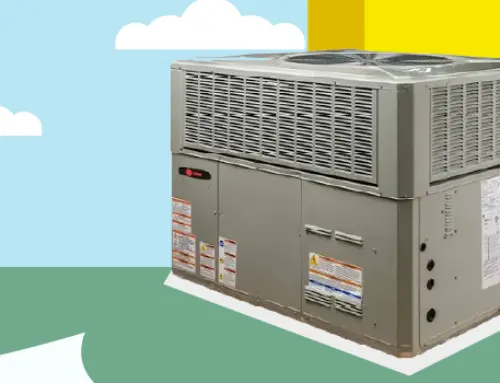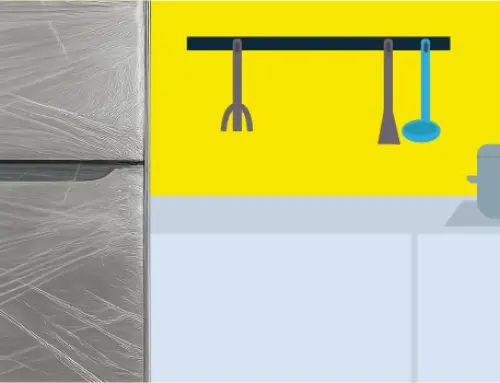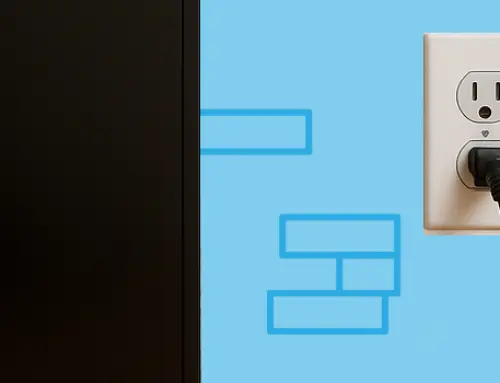What Are the Pros and Cons of Nuclear Energy?
by Tyler Castle
11.7 min read
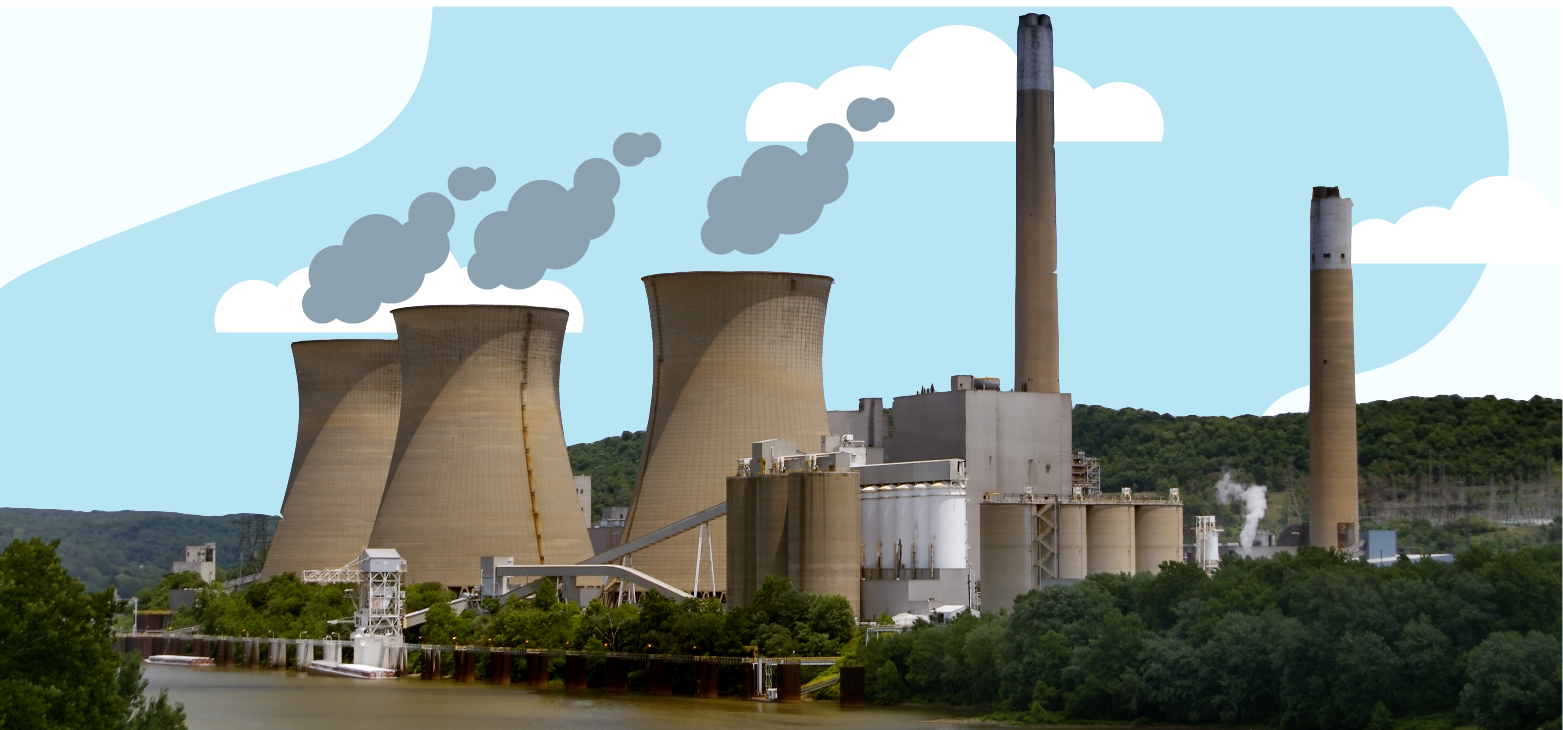
Since nuclear power plants first began operating in the 1950s, opinions around the world have remained sharply divided on whether nuclear energy is a viable and safe source of power.
As the world searches for cleaner and more reliable energy solutions, few topics spark as much debate as nuclear energy. Praised for its ability to produce massive amounts of electricity with virtually zero carbon emissions, yet questioned for its risks, high costs, and radioactive waste, nuclear energy sits at the crossroads of innovation and controversy.
In an era of climate urgency and energy transition, understanding the pros and cons of nuclear power has never been more important. Let’s dive in!
What Is Nuclear Energy?
Nuclear energy comes from the center of an atom, called the nucleus, which is made up of tiny particles called protons and neutrons. We can get this energy in two ways—either by splitting the nucleus apart (that's called fission), or by combining two nuclei together (that's fusion). Both processes release a huge amount of energy that we can use to generate electricity.
The heat produced from nuclear energy is used to boil water and turn it into steam. The steam then spins turbines, which are connected to generators that produce electricity. It's actually pretty similar to how coal or gas power plants work, just with a different heat source.
Using nuclear energy to make electricity is actually considered very safe. When you compare it to coal, for example, the difference is huge—hundreds of people lose their lives in coal mining accidents every year just to supply fuel for power.
Is Nuclear Energy Potential or Kinetic?
Nuclear energy is primarily a form of potential energy. It's stored in the nucleus of atoms, held tightly by strong nuclear forces between protons and neutrons. This energy stays contained until it's released through a nuclear reaction—typically fission, when atoms are split apart.
During fission, that stored (potential) energy is suddenly released and transformed into other types of energy—especially kinetic energy. High-speed particles are set in motion, producing intense heat that's used to generate electricity.
So, while nuclear reactions involve kinetic energy during the process, the original energy source comes from the potential energy locked inside the atom's nucleus.
To sum it up: nuclear energy starts as potential energy, then becomes kinetic and thermal energy when released; but at its core, nuclear energy is classified as potential energy.
How Nuclear Energy Compares to Other Forms of Energy
Every energy source differs in their own way. When comparing nuclear energy to other forms of energy generation, the difference can be vast.
Nuclear energy offers high reliability and low emissions compared to fossil fuels, while reliable and easily scalable, can contribute to pollution and isn't sustainable. However, unlike fossil fuels—which are relatively quick and cheap to deploy—nuclear power plants require high upfront investment similar to installing a solar panel system in your home.
When compared to solar and wind energy, nuclear energy offers greater reliability and consistency, as it isn't dependent on weather conditions. However, compared to nuclear energy, solar and wind are generally cheaper to build, faster to deploy, and don't produce hazardous waste, though they do require battery storage or backup systems and expensive set ups due to their intermittency.
Lastly, geothermal energy shares nuclear's benefit of steady output with minimal emissions, but it's geographically limited and not as widely scalable. In contrast, nuclear energy can be deployed in more varied locations but involves more regulatory and safety considerations.
Nuclear Energy vs. Wind vs. Solar vs. Geothermal vs. Fossil Fuels
| Factor | Nuclear Energy | Fossil Fuels | Solar Energy | Wind Energy | Geothermal Energy |
|---|---|---|---|---|---|
| Reliability | Extremely reliable with a >90% capacity factor; consistent baseload power day and night. | Intermittent—depends on weather and time of day; requires storage or backup for consistency | Intermittent; dependent on daylight and weather conditions | Intermittent; dependent on wind conditions | Reliable and consistent; available 24/7 |
| Cost | High upfront costs and long construction times; lower operational costs over time. | Rapidly decreasing installation and maintenance costs; among the cheapest sources of new power. | Rapidly decreasing; among lowest costs currently | Low and declining; competitive with fossil fuels | Moderate upfront; low and predictable operational costs |
| Scalability | Challenging to scale quickly due to regulatory hurdles and long build times. | Highly scalable—modular, fast to deploy from homes to utility-scale farms. | Highly scalable; modular and deployable at all scales | Highly scalable; suitable from residential to large-scale | Limited scalability; geographically dependent |
| Environmental Impact | Low emissions during operation; concerns over radioactive waste and accident risk. | Minimal emissions and waste; some impact from land use and material sourcing for equipment. | Minimal emissions; moderate land use impacts | Minimal emissions; Land and wildlife habitat impacts, such as birds and bats, can result in injuries or fatalities if they are struck by turbine blades. | Minimal emissions; very low environmental impact |
| Emission | Low carbon | little to no greenhouse gases | Zero emissions during operation | Zero emissions during operation | Low to near-zero emissions during operation |
Pros and Cons of Nuclear Energy
Before deciding where nuclear energy fits into our energy future, it’s important to weigh its benefits against its drawbacks. Like all energy sources, nuclear power has its strengths and limitations that affect its role in a sustainable, reliable energy mix. Here’s a closer look at the key pros and cons of nuclear energy.
Pros of Nuclear Energy
Supports Fast Decarbonization
Nuclear energy helps cut carbon emissions quickly by providing large-scale, low-carbon electricity. In doing so, nuclear power has the potential to replace coal and natural gas in the energy mix without sacrificing reliability. Countries like France and Canada have reduced their reliance on fossil fuels by combining nuclear with hydro, leading to significantly lower emissions and cleaner water.
Recognized as Environmentally Sustainable
Nuclear energy is now classified as a clean source of energy and is widely cleaner than fossil fuel emissions. Nuclear energy only releases 12 grams of CO2 per kWh while fossil fuels release 100+ grams of CO2 making nuclear energy a vastly cleaner energy source. With more and more countries joining in to support nuclear energy, the more efficient this energy source can become.
Recyclable Fuel
Another pro of nuclear energy comes from its extreme recyclability. More than 90% of used nuclear fuel can be reprocessed and reused, reducing energy waste. To put this in perspective, 75% of fossil fuel’s energy is wasted before producing energy. Advanced recycling technologies and next-generation reactors are being developed to extract even more energy from spent fuel, potentially turning nuclear waste into a future energy asset.
Extremely High Reliability
As of 2020, nuclear plants had a capacity factor of over 92.5%, meaning they operated near full output almost all year. That’s significantly higher than wind and solar, making nuclear one of the most reliable energy sources for delivering steady electricity without interruption.
Long Operating Cycles
Nuclear reactors can run for up to two years without refueling, requiring less downtime, maintenance, and more fuel generation. In contrast, fossil fuel plants require more frequent fuel deliveries, and renewable systems can require frequent attention due to battery or system component wear.
Small Land Footprint
Another pro of nuclear energy comes from its small land footprint. It produces a large amount of energy while using far less land than wind or solar farms. Wind farms require at least an acre of land while nuclear power plants only occupy around a mile and half of land.
High Power Output
A single nuclear plant can supply electricity to millions of homes consistently. In 2017, nuclear power plants produced just under 805 kilowatt-hours of electricity. On the other hand, wind turbines produce only 434 billion kilowatt hours of electricity each year. This level of concentrated output reduces the need for widespread infrastructure which can power more homes with less equipment.
Not Weather-Dependent
Unlike solar and wind, nuclear doesn’t rely on weather or sunlight to generate energy. This makes nuclear energy a dependable power source during storms, cloudy days, or calm wind periods—critical for maintaining grid stability and meeting energy demand.
Consistent Base Load Power
Another pro of nuclear energy comes from its consistent base load power. This trait is ideal for meeting the constant electricity demand on the power grid with the ability to run almost 24/7. Other energy sources sometimes have a reduced baseload because they rely on variable factors like sunlight, wind, or fuel delivery schedules, making them less consistent for meeting around-the-clock electricity needs.
Reduces Fossil Fuel Dependence
By integrating nuclear into an energy portfolio, countries can reduce their dependence on coal, oil, and natural gas. This not only cuts greenhouse gas emissions but also increases energy security by relying on domestically available uranium instead of imported fossil fuels.
Low Operating Costs
Though nuclear plants are expensive to build, they are relatively inexpensive to operate once online. With long lifespans and stable fuel costs, they provide predictable and affordable electricity for decades. As a bonus, waste disposal costs are included in the nuclear power plants’ operating costs making them even more cost effective.
High Energy Density
Nuclear fuel contains millions of times more energy per unit than coal or gas. This means small amounts of nuclear material can produce enormous amounts of power, reducing the need for extensive mining and transportation.
Sufficient Uranium Availability
Current uranium supplies are stable and projected to last for several decades. At the time this article was written, there is currently 9 – 22 million tons of uranium left on Earth. Additionally, emerging technologies like fast breeder reactors and thorium reactors may extend fuel availability even further.
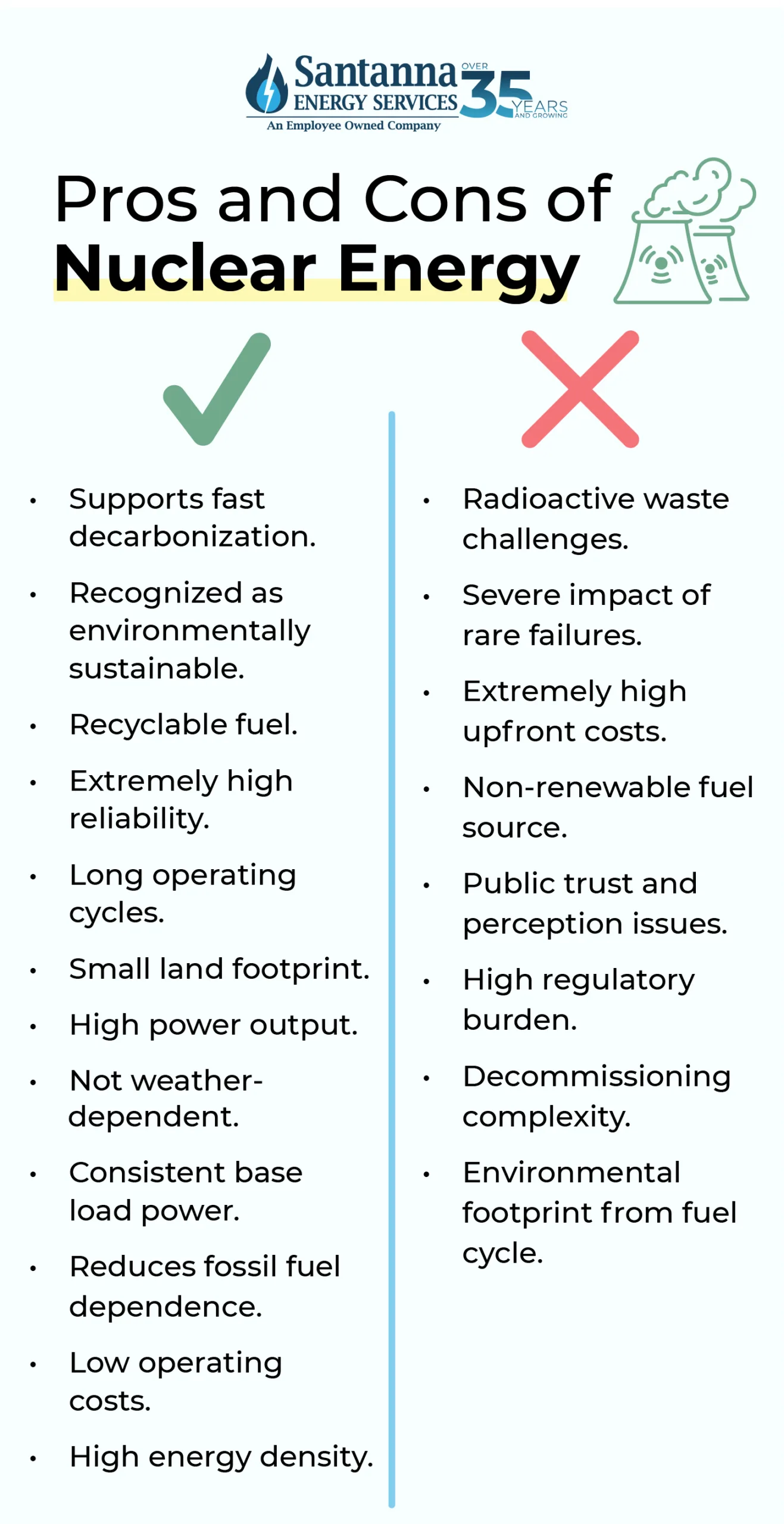
Cons of Nuclear Energy
Radioactive Waste Challenges
Spent nuclear fuel remains highly radioactive for thousands of years and must be stored securely in specialized facilities to prevent leaks or environmental contamination. Unlike other energy sources that produce less hazardous waste, nuclear requires long-term geological repositories and active monitoring, posing technical, political, and ethical challenges for future generations.
Severe Impact of Rare Failures
Although nuclear accidents are rare, their consequences can be catastrophic. Events like Fukushima and Chernobyl led to large-scale evacuations, long-term health effects, environmental damage, and multibillion-dollar recovery efforts. Luckily, these events have shaped global policies to better control and protect from future incidents.
Extremely High Upfront Costs
Building a nuclear plant can cost billions and require over a decade of construction time. A single nuclear power plant can cost $6 billion to $9 billion for each 1,100 MW power plant. These high capital requirements make nuclear less attractive to investors compared to faster, cheaper renewable projects like wind and solar farms.
Non-Renewable Fuel Source
Uranium, the most common nuclear fuel, is a finite resource. While current supplies are sufficient for decades, long-term sustainability is uncertain without advancements in fuel recycling, reprocessing, or alternative fuels. This limitation contrasts with truly renewable sources such as wind, solar, and hydro.
Public Trust and Perception Issues
Despite technological advances, nuclear energy still faces public resistance due to its association with radiation, nuclear weapons, and high-profile accidents. This stigma can delay new projects, influence policy decisions, and reduce investment.
High Regulatory Burden
Nuclear energy is subject to some of the strictest regulations in the energy industry, covering safety, environmental protection, construction, and security. While necessary for public safety, these regulations add layers of complexity and time to planning and construction, often resulting in delays
Decommissioning Complexity
When a nuclear plant reaches the end of its life, safely shutting it down and dismantling it is a lengthy and expensive process. Decommissioning can take decades and cost hundreds of millions of dollars, especially when managing radioactive materials and restoring the site for future use.
Environmental Footprint from Fuel Cycle
While nuclear energy produces minimal emissions during operation, its full fuel cycle—mining, refining, transporting uranium, and managing waste—can negatively impact the environment. Mining operations can degrade local ecosystems and contaminate water sources, and fuel transport carries risks of radiation exposure or spills.
How is Nuclear Waste Managed?
All U.S. nuclear plants initially store used fuel rods in deep water pools made of thick concrete and steel. The water shields radiation and keeps the fuel cool. Once spent fuel has cooled (typically after 5–10 years), it’s moved into stainless steel canisters surrounded by concrete for long-term storage. These casks are licensed for up to 40 years..
Some high-level waste from nuclear weapons programs is immobilized in glass (vitrified) and intended for deep geologic disposal. This process is mandated by federal law for certain waste types such as highly radioactive fission products, transuranic elements like plutonium, neptunium), hazardous chemical components called “mixed waste”).
Roughly 90% of the volume of weapons-related radioactive waste contains just 10% of the radioactivity. The DOE is exploring alternative disposal methods for this type of waste to cut costs and reduce risk.
FAQs
Is nuclear energy truly low-carbon?
Yes, nuclear energy is considered a low-carbon power source. During operation, nuclear reactors produce virtually no direct carbon dioxide emissions. While there are emissions associated with the entire lifecycle—such as mining, fuel processing, and construction—these are minimal.
Can nuclear energy help combat climate change?
Absolutely. Nuclear power plays a vital role in reducing greenhouse gas emissions. According to the International Atomic Energy Agency (IAEA), nuclear power has prevented the emission of over 60 gigatonnes of carbon dioxide over the past 50 years. Its ability to provide large-scale, reliable, and low-carbon electricity makes it an essential component in strategies aimed at mitigating climate change.
While nuclear energy plays an important role in the low-carbon energy mix, it comes with unique challenges like waste management, high upfront costs, and long development timelines. Renewable energy, on the other hand, offers flexible, scalable solutions that are already making an impact today. That’s why many households are looking for simple ways to support cleaner energy—even if they don’t have access to solar or wind installations themselves.
At Santanna Energy Services, we make it easy to support renewable energy through our Earth-Friendly Electricity Plan. When you enroll, we match your electricity usage with Renewable Energy Certificates (RECs)—which support renewable energy projects across the country. Explore your options now!
Tyler is an experienced energy professional, having worked for Santanna Energy Services, for the past four years. He is passionate about renewable energy and believes that diversifying the energy grid is the key to a sustainable future. Tyler is dedicated to supplying consumers with the best possible energy solutions and works diligently to make sure that Santanna can deliver the highest quality service.



